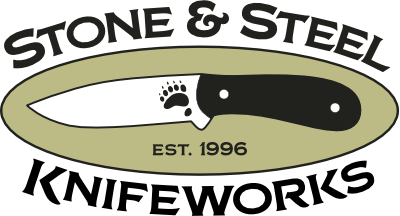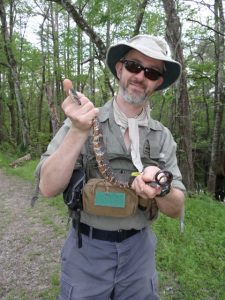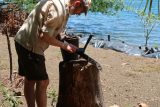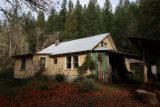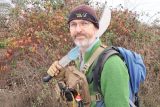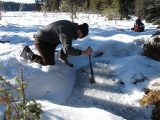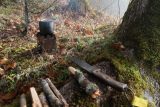I work full time pursuing one of my other passions in life, the natural world. My work as a Wildlife Biologist keeps me very busy as I am often off hiking somewhere in remote areas of the Pacific Northwest chasing critters for extended periods of time. (Actually, you can imagine there is a bit more to scientific research than that…)
My wife and I spend time working on and around the house and the land we own, the very small farm we have. We also enjoy traveling.
My level of interaction with life means that, at this time, I sharpen/repair, and craft, knives on a case by case basis. I seem to be more of a “knife tinkerer” these days.
But if you are interested, I would love to talk with you about knifemaking, or anything else, for that matter. I enjoy questions so feel free to ask about anything you see (or don’t see) here. I don’t believe in knifemaking secrets. Someone was good enough to show or tell me, so I will do the same. Just don’t get cross if it takes me a few days to get back to you.
And if you have a knife in need of some TLC, please don’t hesitate to drop me an email.
Use the contact form to send me an email.
A snapshot of my life up to now
The somewhat abridged version of my life goes something like this:
I was born at home in Berkeley, CA, but celebrated my first birthday in Oregon. I did not have a birth certificate or a SS number until I was 16.
I grew up on a small 70 acre farm in the western foothills of the Cascade Mountains near Myrtle Creek, OR where we grew much of what we ate; I started hand-milking cows at around 7yrs old; raised pigs, chickens, Brown Swiss cows, geese, an occasional duck and many mice and blacktail deer.
My family lived in a small, un-insulated farmhouse, heating and cooking solely with wood. We hand milked our cows and sold the raw milk in our local community, as well as eggs and some produce. We made butter and ice cream by hand and our only source for water was from the creek that ran off of our forest, unprocessed or filtered. In the fall the water typically looked like light tea, due to the tannins from the leaf fall accumulating in the stream.
The land included over 40 acres of mixed forest that was, although logged in the past, of late seral stage and with many fewer enforced rules about private land back then, there weren’t many boundaries I had to follow in my wanderings.
I spent almost all of my free time as a younger person exploring the world around me in the forests and streams where I lived, typically by myself, or with my younger brother.
This environment unquestionably drove my interest and education towards being a naturalist.
That land, that space, I grew up in has a very special place in my heart, and soul. It is not the house or other buildings; but the trees, creeks and hills where I spent so much of my time. I am not denying that I experienced difficult, even occasionally unpleasant times there as a child, but I have no bad memories of being in the woods there. And though my family and I have our own small space now, I feel oddly the most at home, at peace, whenever I am back there.
Those woods, and the “dirt” time I spent there, are what inspired me to work hard, steadily to find (make?) employment in the natural resources and the science of the natural world, before I really even knew you could make a living doing it. It may sound a little extreme, but I think, in many ways, I owe my life to that space and my time there.
For better, or worse, I was blessed with a childhood somewhat limited in “stuff”, etc., but with ample opportunity to spend time out of doors; a lot of time.
I grew up without television, and still have not grown to fully appreciate it.
Without television and few opportunities for entertainment from media, etc. (other than Dad’s radio), books were a large part of my childhood, and occupied the balance of my time when I was not outside (or occasionally when I was outside-something about reading on a summer day in the shade of a big leaf maple). Titles that made a strong impression on me at a young age include Jenkins’ Before the White Man Came, Kroeber’s Ishi (these two both helped me see the impact of colonization early on, as well as feeding my interest in traditional skills) and Sloan’s Diary of an Early American Boy (I am sure the author’s copious drawings played a role in my love for old tools, etc.), and numerous books documenting early legends and mythology of first nations people. I felt very connected to the protagonist in The Education of Little Tree (later I learned there was much more to the stereotyping “story”, and the hypocrisy of Asa “Forrest” Carter…). I read a lot of early science fiction (Vern, Wells, Shaw, Analog magazine) and books by outdoor writers (Seton, London, Paulson, Rawls, Kjelgaard). I treasured my small collection of Golden Nature Guides.
I was home-schooled (what would be termed “unschooled” today) until I entered public school in the latter half of the 5th Grade.
After graduating from high school I went on to get a degree in biology at Reed College in Portland, Oregon. After finishing my Thesis in Animal Behavior and Conservation Biology at Reed, my fiancée and I needed a break, so we had a public celebration of our union and joined the Northwest Service Academy (Americorps) and moved to Trout Lake, WA. We both had a truly amazing time over the next two years, and learned a great deal, as well as feeling that we did something significant to help our country and world. We then moved back to Oregon. I pursued my “career” as a scientist, and my wife obtained a license in Early Childhood Special Education, going on to teach for a local ESD.
We purchased a little bit of land with an older home on it near Albany, OR, and our son was born several years after that.
Various interests
I can be obsessive/compulsive and opinionated at times.
I try to love life and enjoy the small and simple aspects of the universe and how I interact with it. That is not to say there aren’t days when I get frustrated with Life, The Universe, and Everything. But I do try to be optimistic and enjoy my time here without intentionally causing others undue pain or suffering, or being in a hurry to get to the end. So far, that approach seems to work for me. I am not perfect, and I hope I never am.
I have many other interests and pursuits. Some of these (at this time) include just about all aspects of natural history, ethnobotany, indigenous technology and living skills, traditional field craft, outdoor photography, small-scale homesteading and all that it entails, and discussing and implementing ideas and methods for increasing our positive impact on the world and people around us.
Hey, at least I am never bored…
Sources of inspiration
Books continue to play a significant role in my life, my continuing pursuit of knowledge.
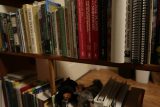
Over years I have built a not insubstantial reference collection of books related to natural history, indigenous knowledge, traditional skills and the outdoors.
I can’t seem to stop myself from checking out a bookstore when I see one in my travels, hunting for additions.
I also enjoy reading about other’s experiences in the outdoors.
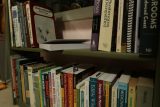
I have a deep appreciation for the natural world; all aspects of it fascinate me, and outside is where I feel the most at home.
It is a very big part of who I am, how I spend my time.
Although I think I would be considered friendly, and enjoy socializing and spending time with others, I truly relish my alone time in the outdoors. Scouting, foraging, or just looking for the opportunity to share time with a critter in its daily life. Be it in the forested mountains, open shrubby valleys, along streams, it is a blessing. It is important to me that I participate in the world, the outdoors, not just walk through it.
I am often asked where my passion for the natural world and enthusiasm for traditional/outdoor skills came from. While I don’t remember either of my parents, or other relatives, spending any dedicated time instructing me on natural history, or outdoor skills, I know that growing up so close to (in) the woods, and having little else to occupy my time (few commercial “toys”, no television, not in public school, etc.), played a significant role. My own search for knowledge, which probably came from my father, certainly drove me to explore and learn.
I believe the most influential source of direct outdoor knowledge and skills as a child was a family that lived a few miles up the road from our farm.
The oldest son was my only real peer during those early years (I admired him, looked up to him like a big brother), and I spent a lot of my childhood with them, on their farm, or on fall gatherings in the mountains.
One of my most valued possessions is a Be Prepared Pin the father (actually a scout leader) gave me, although I was never in the Boy Scouts, telling me I always seemed prepared when we were out together.
While I learned so much from them, especially the father and son (including game trapping techniques, wild plant harvesting and use, respect of cultural artifacts, and more), it was all shared as simply daily living skills.
While I always knew they identified as members of the indigenous nation local to the area, it was not something we every talked much about when I was younger, and it was not until many years later that it was pointed out to me the significance, and opportunity, of this experience,
I have been given a number of nicknames over the years…smiley, farmboy, hippie, Rambo, knifeguy, swamp thing, frogman… all with their own story. At some point along the path I picked up the nickname Woodrat. I think that one fits the best. It is kind of a variation on the term used for a person who enjoys bumming around in the desert environs, a Desert Rat. But I love the woods the most…
Coincidentally, I was born in the Chinese year of the rat, and have always appreciated the rodent family for its member’s high level of intelligence, adaptability and cleverness. I have spent a lot of time around Bushy tailed woodrats (fairly common in the Pacific Northwest, but rarely actually seen) as a kid and for a few years relocated them from folks’ houses, shops and barns.
Given my life experience and my close to three decades as a full-time field scientists, I believe I possess unique qualifications regarding outdoor skills, preparedness, and knife/tool use and design. Most of my knife and tool designs come directly from my experiences outdoors, driven by the desire to create a tool that will work well there. When I am working on a design, I am often impatient to get out and test it in the field to see if it will meet the need I imagined.
My full time profession allows me many unique opportunities, one of which allows me to teach/share outdoor skills regularly to adults, something I greatly enjoy. One of my primary duties is to hire, train and supervise our lab’s research field crew every year. This crew ranges in size from 2 to 8 individuals, depending on the year and our goals.
In addition to training them how to conduct rigorous scientific sampling to our strict study protocols, I teach outdoor safety, risk assessment and management. I also incorporate other topics and skills including natural history, camping and backpacking, woodcraft, firecraft, knifecraft, emergency prepardeness, basic first aid and traditional plant use.
I share the ideas of permission, respect, and reciprocity to facilitate a more personal relationship with the natural world.
In recent years, I have been finding more opportunities to share outdoors skills with folks of all ages outside of my work environment.
While it would be easy to say that my outdoors skill set was self taught, I am very reluctant to see it that way. While I have attended a few instructor lead “classes”, such as outdoor leadership and wilderness medicine trainings, more importantly everything I know I’ve learned from reading and listening to others, observation, intuition, my own dirt time; so many people (and I don’t mean just upright posturing two-leggeds…) have directly and indirectly shared their knowledge with me it would be a degree of arrogance to say that it all came from me. I owe a debt of gratitude to all those who came before me, occupy the same space and time as myself from whom I have learned so many different life skills.
Below I share an abbreviated list, in no particular order, of some of the places I have had the opportunity to explore/adventure in, hoping to inspire you to get out there.
Umpqua National Forest
Mt. Hood National Forest
Ocala National Forest
Parque Nacional Tikal
Elliot State Forest
Yellowstone National Park
Parque Nacional Valcon Masaya
Everglades National Park
Big Cypress
Lago Atitlan
Three Sisters Wilderness
Fakahatchee Strand State Preserve
Redwood National Park
Semuc Champey
Banff National Park
Biscayne Bay Aquatic Preserve
Olympic National Park
Wrangell-St. Elias National Park and Preserve
Atchafalaya National Wildlife Refuge
Reserva Natural Atitlan
Crater Lake National Park
Jasper National Park
Merritt Island National Wildlife Refuge
Laguna de Apoyo
Bull of the Woods Wilderness
Glacier Bay National Park and Preserve
Reserve Nacional Padre Ramos
Drift Creek Wilderness
Valley of the Kings
Joshua Tree National Park
Mountain Lakes Wilderness
Opal Creek Wilderness
Midland Provincial Park
Steens Mountains
Bogue Chitto State Park
Lassen National Park
Anza-Borrego State Park
Lava Beds National Park
Rock Creek Wilderness
